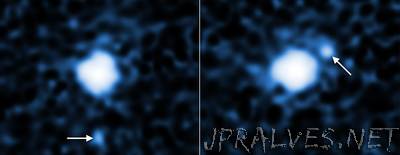
“The combined power of three space observatories, including NASA’s Hubble Space Telescope, has helped astronomers uncover a moon orbiting the third largest dwarf planet, catalogued as 2007 OR10. The pair resides in the frigid outskirts of our solar system called the Kuiper Belt, a realm of icy debris left over from our solar system’s formation 4.6 billion years ago. With this discovery, most of the known dwarf planets in the Kuiper Belt larger than 600 miles across have companions. These bodies provide insight into how moons formed in the young solar system. “The discovery of satellites around all of the known large dwarf planets — except for Sedna — means that at the time these bodies formed billions of years ago, collisions must have been more frequent, and that’s a constraint on the formation models,” said Csaba Kiss of the Konkoly Observatory in Budapest, Hungary. He is the lead author of the science paper announcing the moon’s discovery. “If there were frequent collisions, then it was quite easy to form these satellites.” The objects most likely slammed into each other more often because they inhabited a crowded region. “There must have been a fairly high density of objects, and some of them were massive bodies that were perturbing the orbits of smaller bodies,” said team member John Stansberry of the Space Telescope Science Institute in Baltimore, Maryland. “This gravitational stirring may have nudged the bodies out of their orbits and increased their relative velocities, which may have resulted in collisions.” But the speed of the colliding objects could not have been too fast or too slow, according to the astronomers. If the impact velocity was too fast, the smash-up would have created lots of debris that could have escaped from the system; too slow and the collision would have produced only an impact crater.”
